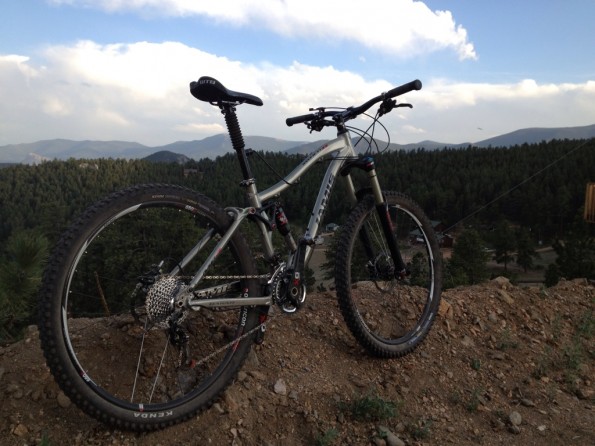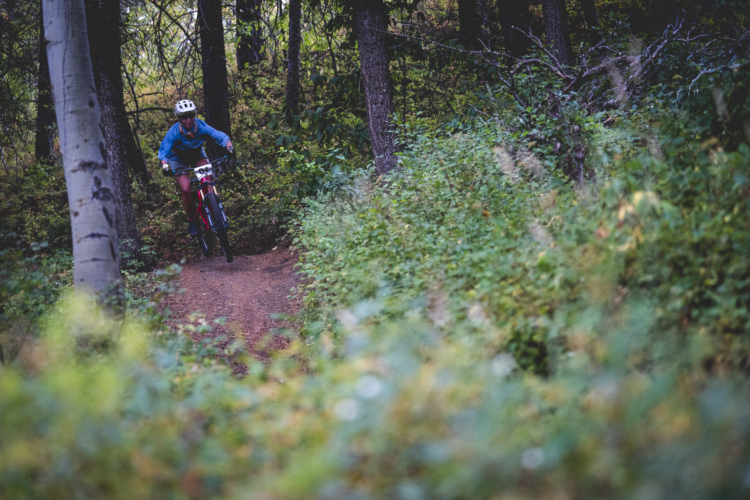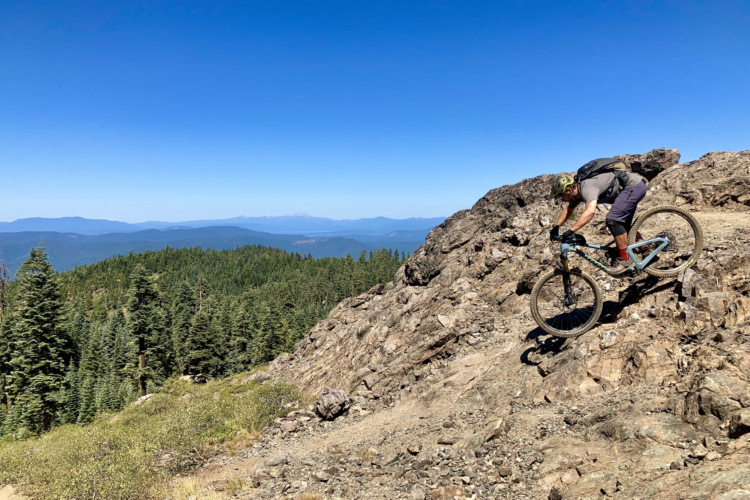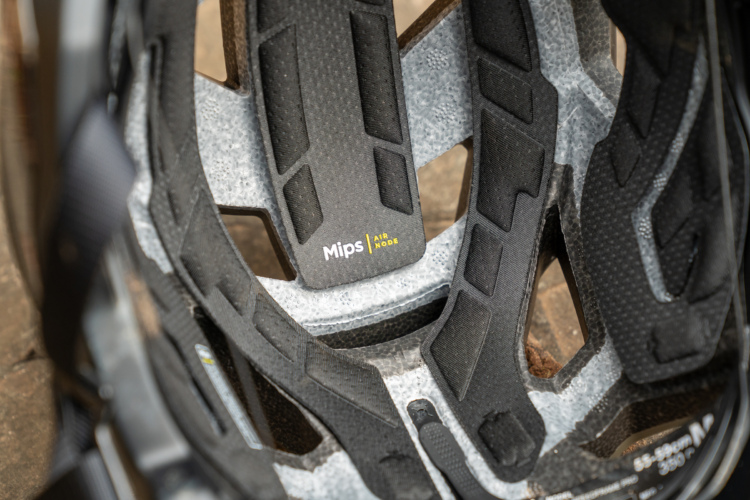Test riding mountain bikes at an expo is a lot like sampling teriyaki chicken at the mall: it all tastes good, but you can’t really tell which is the best until you’ve eaten a full serving.
After demoing the 2012 Jamis Dakar SixFifty B Pro at the Southeast Bike Expo in February, I knew that I had to have a full-size helping of this delicious meal. Jamis was stoked to get one of their rigs into my hands for review, and shipped me one as soon as the container full of bikes arrived from the Far East.
Specs
The frame is made of a “Kinesium alloy” and features a 69-degree tapered headtube (more geometry specs available here). While at first I thought the term “Kinesium” was just a creative way to market an aluminum frame at a high price point, according to Sal, Jamis’s product manager, it is anything but:
Kinesium was developed by Kinesis engineers to raise the standard and lower the weight of bicycle frames. Twenty-five percent stronger than traditional 7005 series aluminum, Kinesium allows us to build frames using thinner butted tubing with no compromise to frame strength.
The frame sports an mp4 suspension linkage with a RockShox Monarch RT3 (130 mm of travel), 10 mm hardware, and cartridge bearings in all the pivots. Moving farther back, the rear end sports 12 x 135 mm thru-axle dropouts with a stock Maxle Lite rear axle and asymmetrical chain stays to provide superb rear-end stiffness. No detail has been left out on this frame, with routing for a dropper post already in place along with tabs for a chain guide.
Up front, a White Brothers Loop TCR 650B fork with 15mm thru axle, 32mm stanchions, and a tapered alloy steerer control suspension duties with 130 mm of travel. Wheels are American Classic 650b XC Disc (hubs and rims), and they hold Kenda Nevegal 650b tires (2.35″ front and 2.1″ rear).
The brakes are a very respectable SRAM X0, with an almost completely blinged-out 2×10 X0 drivetrain (besides the X9 front derailleur).
I’ve spent a significant amount of time on 2×10 SRAM X7 and X9, and Shimano 3×9 XT over the past couple of years, and I was seriously impressed by the performance of the 2×10 X0 drivetrain. At first I thought the increase in performance would be slightly better than the X9 drivetrain (along with a little less weight), but I’m now firmly of the opinion that X0 shifts significantly smoother and is much, much more durable! For more information on SRAM’s X0 2×10 drivetrain, check out Jeff’s detailed two-part review: Part I, Part II.
A WTB volt saddle will hold your weight and take care of your sensitive parts, and a Ritchey Pro Rizer with a 20 mm rise, 670 mm width, and Jamis lock-on grips on the end complete the stock contact points.
Out on the Trail
It didn’t take me long to get acquainted with the geometry of this mountain bike: this is one of those rigs that feels like you’ve ridden it for years. Once I got the suspension adjusted properly and made good use of the dropper post routing by swapping out the stock post for a dropper, I was ready to rip!
I have put over 700 miles onto this mountain bike in the short three month time period that I’ve had it. I’ve ridden this bike on all kinds of trails in six different states, ranging from fast and flowy to tight and twisty to so gnarly I should have been running a dual-crown fork.
This bike was my go-to rig during my epic summer road trip. Some of the gnarliest trails I’ve ridden it on include, but are not limited to:
- Blackjack Trail, Bailey, Colorado
- Kenosha Pass to Georgia Pass, Bailey, Colorado
- Arkansas Hills Trail System, Salida, Colorado
- The Whole Enchilada, Moab, Utah
- Slickrock, Moab, Utah
- Downieville Downhill, Downieville, California
- Soquel Demonstration Forest, Aptos, California
- Mount Lowe, Pasadena, California
- Hummingbird Trail, Simi Valley, California
- Aliso Creek, Laguna Beach, California
- Snow Summit Mountain Resort, Big Bear, California
- Hightower Trail, Dahlonega, Georgia
If any bike I’ve ever reviewed has received a true punishment, this would be the one!
The Dakar SixFiftyB lands squarely in the “trail” category, but the edges around the category got downright hazy when I actually got the bike into some gnarly terrain. While many of the details, such as the dropper post routing, chain guide tabs, the big knobbies, and 5.5″ of suspension allowed me to shred this bike like an all-mountain rig, the other details give it more of a cross-country feel. The rather steep 69 degree headtube angle (for a bike with 5.5″ of suspension), long stem, bars that I wish had been wider, a fixed-position stock seatpost, and the XC American Classic wheels limit the utter gnar factor.
None of these things are good or bad–they’re just the character of the bike. In fact, the American Classic XC wheels performed remarkably! I ended up putting big dents in both rims and breaking a spoke, but after the second rim dent I thought to myself, “what’s up with these wheels?” That was the first time that I realized these were XC wheels: not trail or AM wheels, XC. I pushed these wheels hard on extended rock gardens, drops, and brutal G-outs on trails such as the infamous Porcupine Rim and Downieville Downhill. Heck, I even tried to keep up with guys on full-blown DH rigs with massive dual-crown forks and DH wheels while shredding at Snow Summit!
In short, I pushed these wheels way past their intended use, and they still came through the fire in one piece. Despite the two dents in the rims, these wheels still track very straight, and I’m still riding them hard. Smart choice, Jamis.
Click here to read Part 2 of this long-term review.

















28 Comments
Sep 12, 2012
Sep 12, 2012
Looks like they have another model of the 650 with beefier parts and a slacker geometry:
http://www.jamisbikes.com/usa/thebikes/fullsuspension/dakarxct/12_dakarxctcomp_geo.html
So I guess they just got you confused with an XC guy. lol
Sep 12, 2012
Sep 12, 2012
Sep 12, 2012
Sep 14, 2012
Sep 12, 2012
I don't find the 69° to be that weird considering you are running a larger diameter wheel. It should behave similar to a 26er with 68° I know there are complex formulas concerning how the larger diameter wheel encounters obstacles, yada yada, but for the intended purpose of the bike, I get it.
Stans is releasing their Crest and Flow wheels in 650b next month. The Flow wheels would be perfect for this bike!
The bars are 670mm ... my 29er bars are 690mm and I wouldn't really want to go much wider. More to the point, when I tried the bike, I didn't immediately go "Wow, these bars are so narrow!" :D
Looking forward to Part 2!
Sep 12, 2012
Sep 12, 2012
Sep 12, 2012
#justsayin :D
Sep 12, 2012
Some of the component choices do seem a bit surprising (narrowish bars, XC wheels) but like you said, that's what gives the bike its character. I wonder if the wheel choice in particular was dictated by market availability at the time?
The head tube angle seems pretty reasonable I guess. If anything it's sorta at the high end for an AM bike but combined with the rake of the White Bros. fork it sounds like it works.
Sep 12, 2012
With the stock build, it's way more XC.
But if you put a 6" fork on it, it would rake out the head angle even more and add some more forgiveness in the gnar. Add in tougher wheels, maybe wider tires, wider bars, shorter stem, dropper post (which I did do), and a chain guide/bash guard up front (maybe even go with a 1x10 setup), and you'd have a VERY capable all-mountain bike!
Sep 12, 2012
Seriously though, not a a bad looking - or sounding - bike & build. I wouldn't mind throwing a leg over it. Just for a test of course. I roll 26. Looking forward to the conclusion.
Sep 13, 2012
Like you installed a dropper post you should also try the bike with wider bars and shorter stem. That would be some very helpful info I believe for those interested in the bike.
Now, you didn't mention this in the test but that WB Loop fork has 2 more internal travel adjustments of 140 and 150mm of travel. You might not have a chance to try it this way (would be interesting though) but potential buyers should know and might be concerned about the stock 69 degree HA with the fork set at 130mm. Also it's available as a frame only from Jamis which if it's like the 2011 model also includes the Loop fork and a headset (shock of course) so don't let the price scare you.
Sep 13, 2012
Sep 13, 2012
Sep 14, 2012
Sep 13, 2012
What is this 26er of which you speak? Do they still make those? :D
Sep 14, 2012
So funny.
But I'm still buying a 26" DJ bike when I get a chance ;)
Sep 12, 2012
Great review so far, looking forward to the rest of it.
Sep 12, 2012
Sep 12, 2012
Sep 13, 2012
http://vimeo.com/27493689#
Yeah, Jamis makes no mention it's a 130/140/150 fork. At 150 maybe it would stress the frame but it sure would be more AM stable.
Please try a shorter stem and wider bars (if you still have the bike). Those changes would take some of the XC edge off and be an even more trail worthy bike.
Sep 13, 2012
Sep 12, 2012
Sep 12, 2012
Sep 12, 2012
Sep 12, 2012
And no, I will not be back. I have waaay too much fun on my 29er.